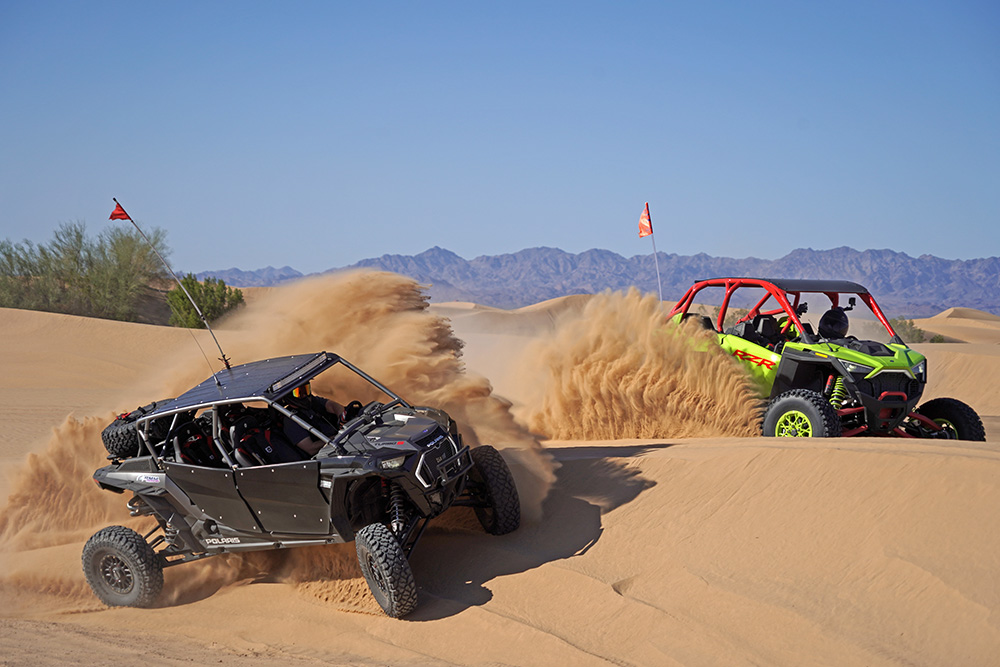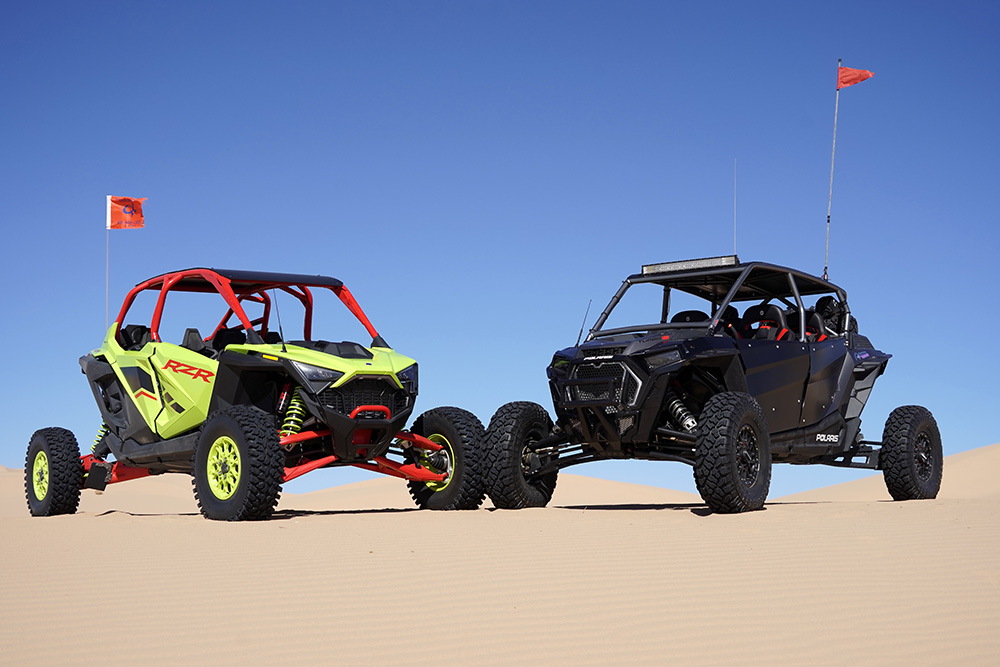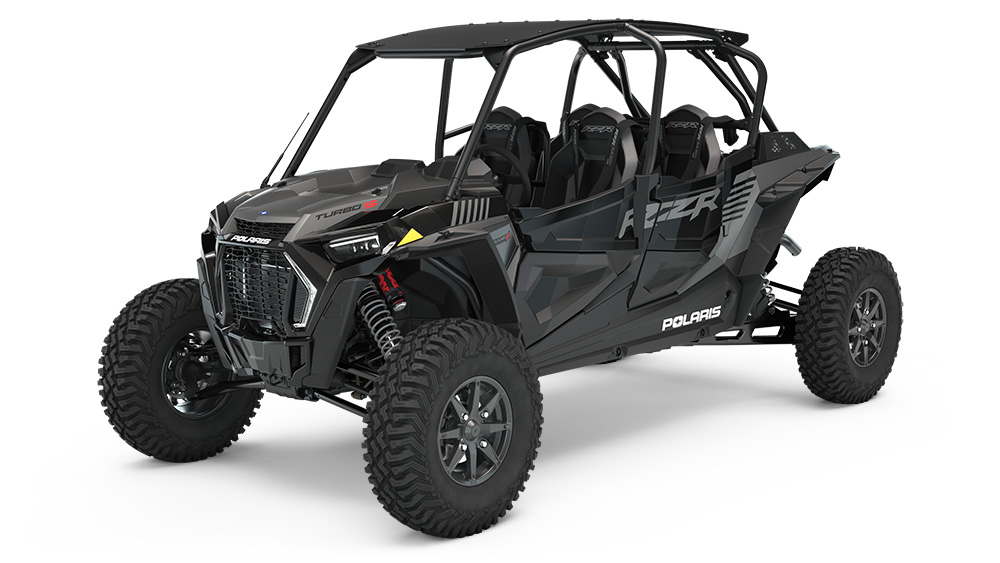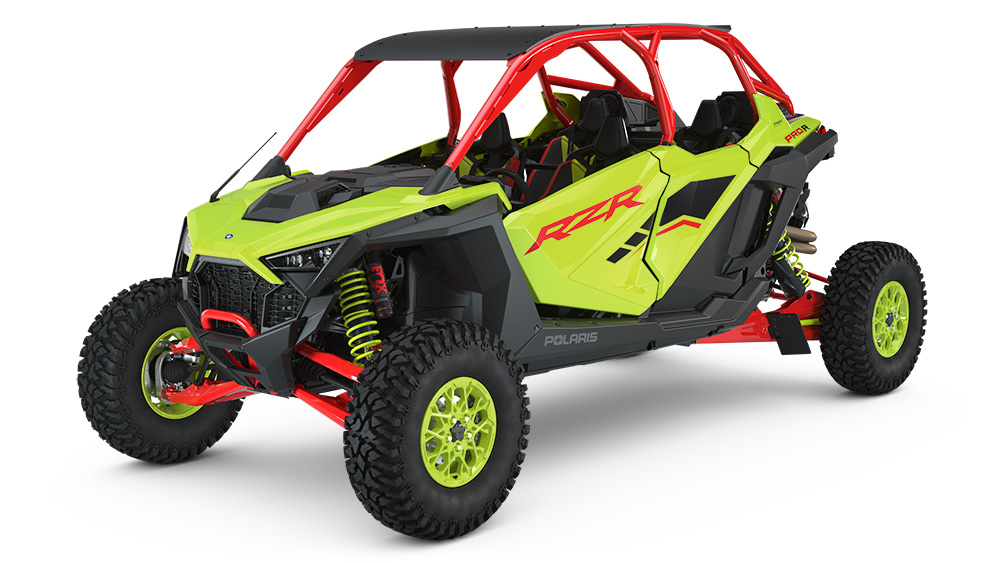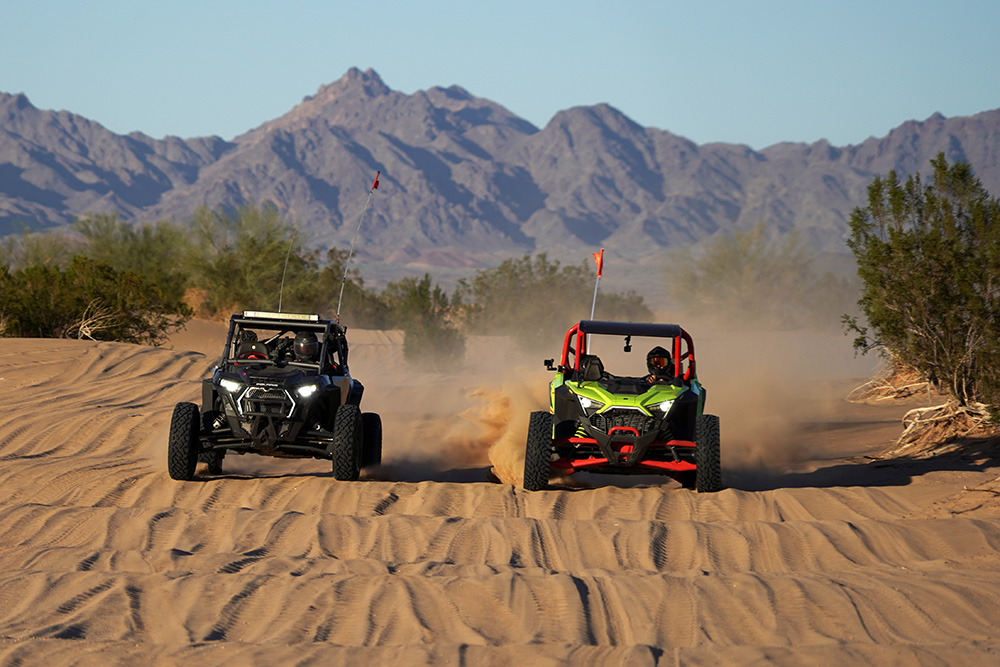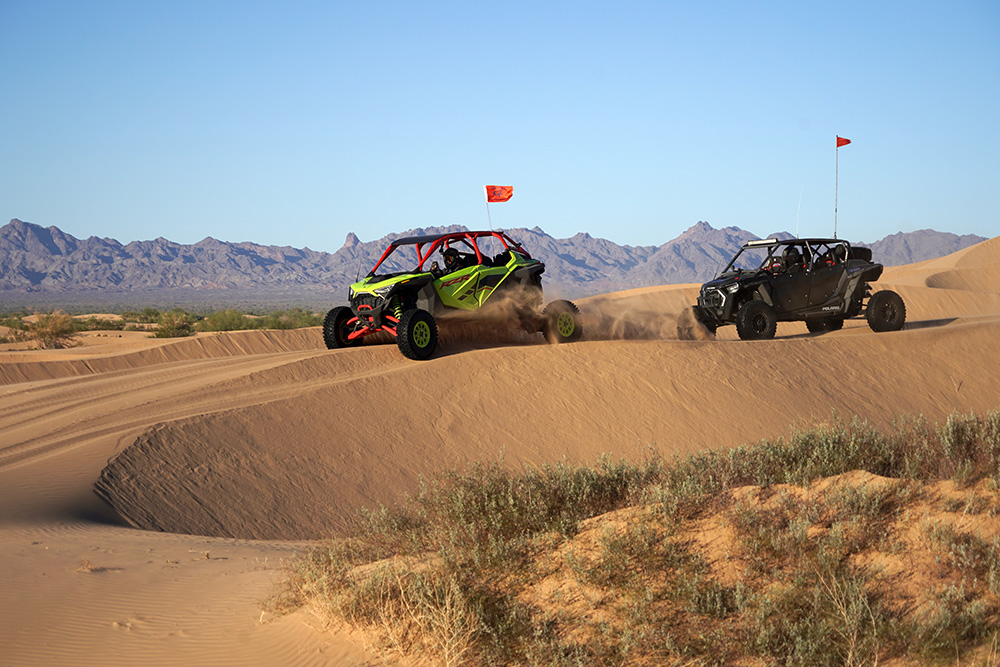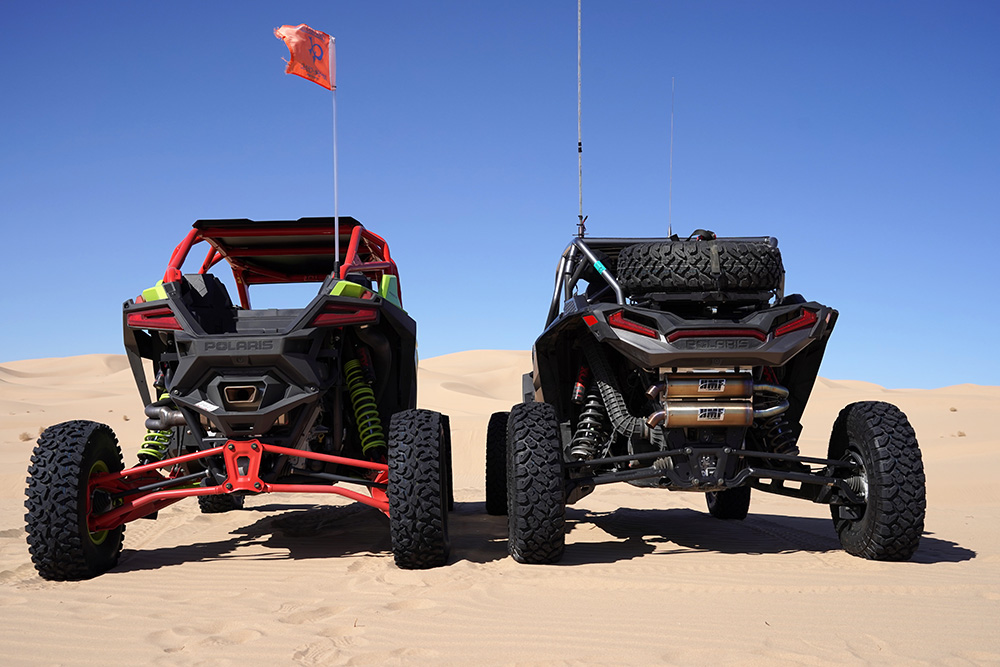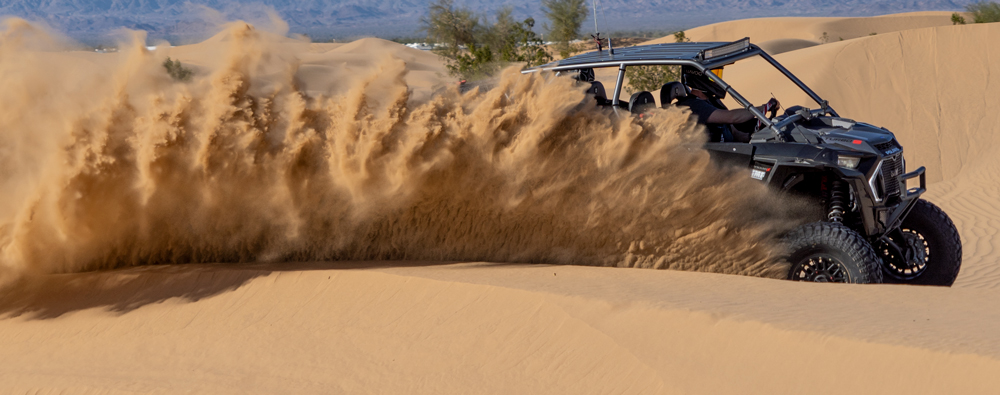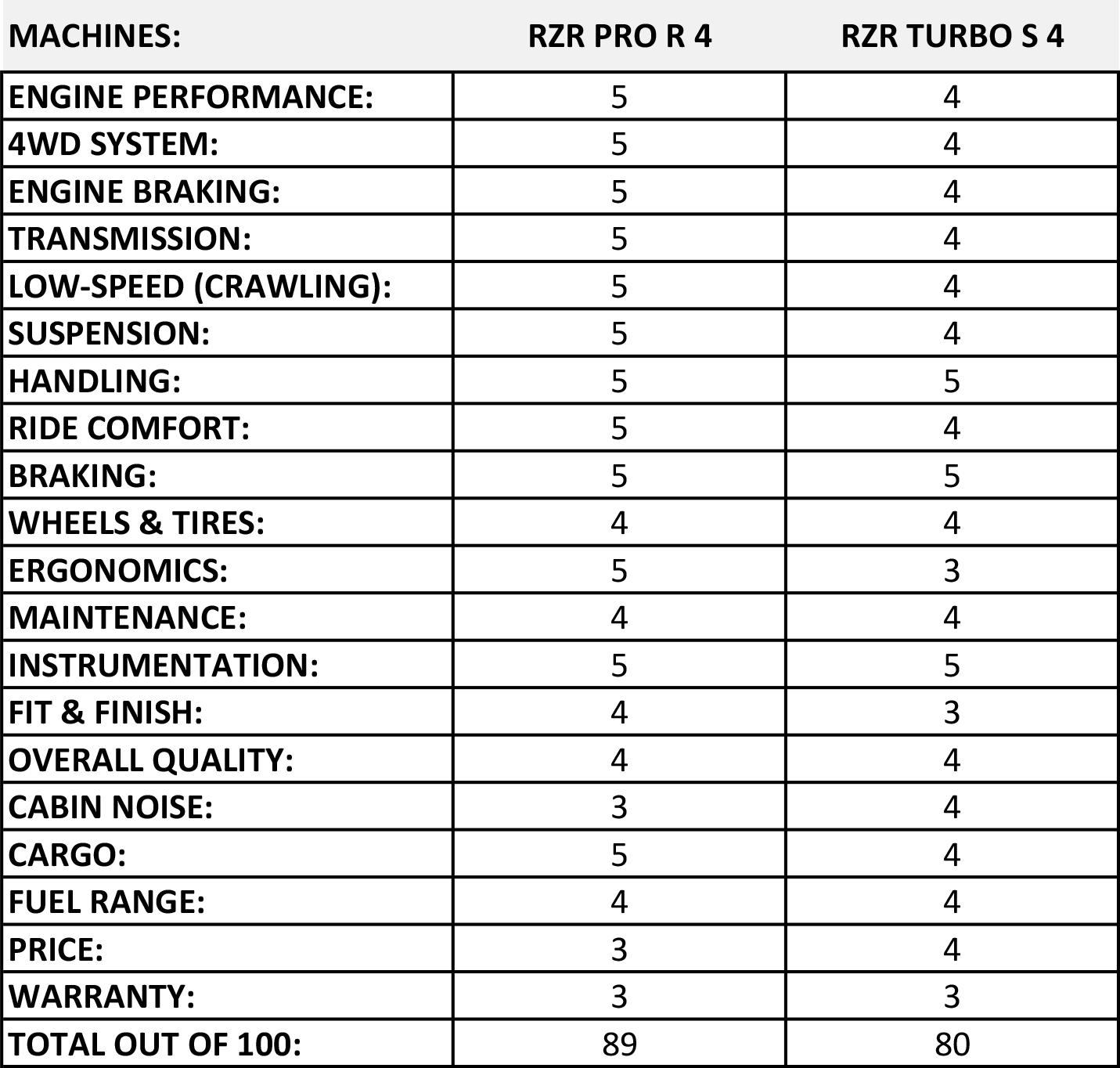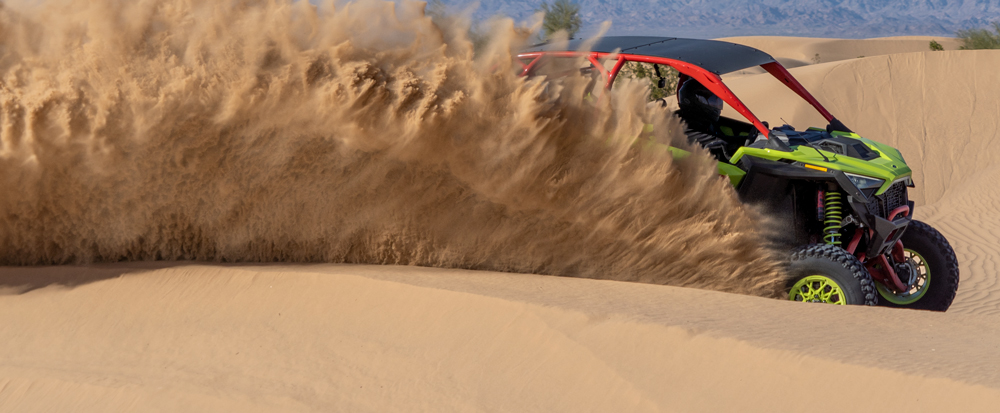A new vs old UTV Comparison between the all-new Polaris RZR Pro R 4 vs Polaris RZR Turbo S 4 high performance UTV models.
UTV Comparison: Polaris RZR Pro R 4 vs Polaris RZR Turbo S 4
Words: Cody Hooper // Photos: Bradley Howe
POLARIS RZR TURBO S 4 Highlights:
- Lightweight and agile
- Turbo motor makes a great noise and decent thrust
- Dynamix and long-travel suspension make for a plush ride
- Ride Command with easy accessory integration
- Classic, aggressive RZR styling
POLARIS RZR PRO R 4 Highlights:
- Lightning-quick engine response coupled with big power
- Suspension travel for days (weeks?)
- Superior Interior to the last-gen RZR Turbo S
- Ride Command with easy accessory integration
- A generational leap for the Sport UTV class from behind the wheel
Engine:
With 168 horsepower from a 925cc turbocharged parallel twin engine, the Turbo S 4 is down a whopping 57 horsepower against the Pro R. Stock for stock, however, the Turbo S 4 is also 493 pounds lighter, which is a massive difference. This gives the Turbo S a power to weight ratio of 11.8 pounds per horsepower, whereas the Pro R only carries 11.0 pounds with every pony. While incredibly close on paper, the Pro R will out-drag the Turbo S every time, increasing the gap to its top speed somewhere around 90 mph. The Turbo S 4 you see here runs up to about 84 mph before it runs out of steam.
The Turbo S is smooth with its power delivery. Turbo torque hits quickly when you whack the throttle open, and the revisions Polaris made to the clutch for the 2021 model year bring smoother engagement and better belt grip than previous models we have tested. The Pro R is a different experience than the Turbo S from behind the wheel. Its large 1997cc inline four-cylinder engine is rev-happy and very responsive, with an emphasis on high-RPM power that is exciting to wring out.
While both engines are powerful, the Pro R’s snappy, naturally aspirated power delivery was an instant hit with every one of our test drivers. It also delivers far stronger low-RPM performance than the turbo mill in the S, meaning low-speed crawling and maneuvering is made simpler. The Turbo S’ engine is now a couple of generations old, with the Pro XP and Pro Turbo both getting a newer, 181 horsepower Prostar turbo twin.
Transmission/Drivetrain:
The Pro R again takes the win here, as it features Polaris’ latest PVT clutching system with a massive difference in component size. The belt and clutches in the Pro R are massive, and we have yet to hear of a blown belt from any of the Pro R owners in our circle. This is aided by the Pro R’s dual-path clutching, which forces cool air over the front and back of the clutches. The Turbo S received an upgrade to its clutching for the final model year, which allowed us to beat on it hard in Glamis with no belt issues, but it still does not carry the robust improvements present on the new Pro R.
Both feature a high/low speed continuously variable transmission with a drive belt, but the way they feed power to the tires is very different. The Turbo S uses Polaris’ “Isolated Xtreme Performance AWD”, which is a speed-sensitive system that only feeds power to the front wheels when the rears slip. It works well and makes the Turbo S a decent climber, but at times you can feel it working. It isn’t as reliable in low-traction situations as a true 4WD locked drivetrain.
The Pro R, on the other hand, features a first for Polaris – dubbed “Pro Performance True 4WD”, the new system has three modes: 2WD, 4WD with open front diff, and 4WD diff lock. Much like the Yamaha and Kawasaki 4WD systems, this allows the driver to lock the vehicle in and ensure consistent, predictable traction. We must give the nod to the Pro R, especially when you dial in the onboard electronics for low-speed crawling work. The Pro R’s adjustable engine and suspension settings allow you to dial in a feel that works for your driving style, and it all harmonizes to make easy work of low-speed crawling situations.
Suspension:
Both vehicles feature long-travel suspension and electronically controlled shocks. Polaris uses a couple of metrics for suspension specifications, the first of which is “usable travel”. According to Polaris, “Usable Travel is measured, with the vehicle in full droop, from the bottom of the tire to the bottom of the skid plate.” This number assumes that you can count on the entire sidewall of the tire to absorb impact, which is very misleading. Here’s how the “usable travel” numbers stack up:
RZR Turbo S 4 Usable Travel: 25 inches front, 25 inches rear
RZR Turbo S 4 Wheel Travel: 19 inches front, 21 inches rear
RZR Pro R 4 Usable Travel: 27 inches front, 29 inches rear
RZR Pro R 4 Wheel Travel: 22.25 inches front, 24.5 inches rear
As you can see, the wheel travel numbers tell a more realistic story, but even there, you miss half of it. The Pro R’s suspension geometry is superior to the Turbo S, as it should be – Polaris had years to go back to the drawing board with the Pro R and fix the geometry issues that long-travel suspensions present. Bump steer, toe change, camber change, and scrub are all decreased drastically on the Pro R versus the Turbo S, meaning its travel is not only more abundant, but of a higher quality.
Both cars feature a Dynamix onboard suspension computer, which looks at multiple sensors and uses algorithms to decide on shock stiffness values. On the Turbo S, Dynamix only handles compression stiffness, whereas on the Pro R, the all-new Dynamix DV system also adjusts rebound. Performance from the driver’s seat with both cars is stellar, as they offer adjustable stiffness levels on the dash and can compensate for steering input, throttle and braking as well. The Pro R gets another useful feature over the Turbo S, which is the red “X” button on the steering wheel. Hold that button down, and the Pro R’s shocks go into full stiffness, great for surprise impacts and spots where you need to retain ride height.
Either one of these cars will have you smiling ear to ear as you blitz through massive bumps and whoops, and they are both incredibly capable performers. For those looking for the absolute bleeding edge of suspension performance, however, the Pro R is a more enticing choice. You can drive a Turbo S almost as hard as a Pro R, but you will be more comfortable in the newer car at the limit.
Interior:
This is one of the areas where the Turbo S and Pro R are furthest apart. As we have reported before, the Pro chassis’ interior layout is far more favorable than the Turbo S’, especially for larger humans. The Pro R features more interior room in absolutely every dimension than the Turbo S, as well as a lower seat height, much better interior layout and panel fitment, and much more comfortable seats.
The stock seats and harnesses in the Turbo S are not up to the task of keeping occupants planted in such a high-performance offroad vehicle, and the Pro R makes a big jump in the right direction. The bucket seats in the Pro R are far more comfortable and much more stable feeling, as they don’t rock around like the OE Turbo S seats. Any Turbo S owner serious about driving their car will likely option for an aftermarket set of seats and harnesses, just like we did with this project car.
More comfortable seats, a tilt and telescoping steering wheel, wider doors, and better OEM belts make the RZR Pro R more comfortable to drive hard than the Turbo S 4 in stock trim. We would still option for a true 5-point harness in the Pro R to keep occupants secured, as the Pro R’s performance is breathtaking. We applaud Polaris for the increased safety provided by the welded roll cage, reinforced frame, and aluminum roof – all things we added to our Turbo S 4 from the aftermarket.
Tires/Wheels/Brakes:
Here, we had some split decisions from our test crew. Both the Turbo S and Pro R feature non-beadlock 15-inch wheels wrapped in 32-inch tires. The Turbo S uses ITP Coyote rubber, and the Pro R Maxxis Rampage Fury tires. Both have their distinct advantages and disadvantages- the Coyote is a decent desert tire but lacks sidebite. The Rampage Fury is a great all-around tire, but the chunky side lugs get chewed up fairly easily. Either way, we would likely upgrade to a new set of beadlock wheels and a more substantial tire, but only after the stock rubber was worn down.
Braking on both machines is excellent, with a slight nod to the Pro R for having some trick parts like two-piece aluminum hat rotors and better pedal spacing for two-foot driving. Either one has no problem locking up all four 32-inch tires when you stand on the slow pedal.
Impressions:
We chose to compare this Pro R 4 to a modified Turbo 4 S as they both represent cars around the same price point (if you can get the Pro R around MSRP). The Pro R 4 shown here is $13,000 more expensive than the Turbo S 4 at MSRP, and actual out the door cost was another $15,000 higher on the Pro R, totaling $60,000. You can almost buy two Turbo S 4’s for that price – or one with a ton of modifications, a new trailer, and another $10,000 still left in your wallet.
We set off to test the cars back-to-back in the desert and then to a photoshoot in Glamis, swapping drivers frequently and running the gamut on suspension settings, loading gear in and out of the cars, and more. After a couple of days of seat time and a lot of nasty terrain, it is safe to say that these cars are properly separated by their MSRPs, even if both cars are priced higher than we would like.
The Pro R offers a level of suspension above the Turbo S in every regard, being faster, better suspended, more comfortable, and easier to drive. It’s not to say the Turbo S is a bad car by any stretch of the imagination- in fact, many desert races are still being won by Turbo S drivers. If you never get behind the wheel of the Pro R, your Turbo S will continue to feel like one of the absolute best desert play cars ever invented, and that’s because it is. Every once in a while, even a talented artist can upstage their previous performances. That is precisely what Polaris has done with the new Pro R.
UTV Comparison Chart: Polaris RZR Pro R 4 vs Polaris RZR Turbo S 4
Specifications:

